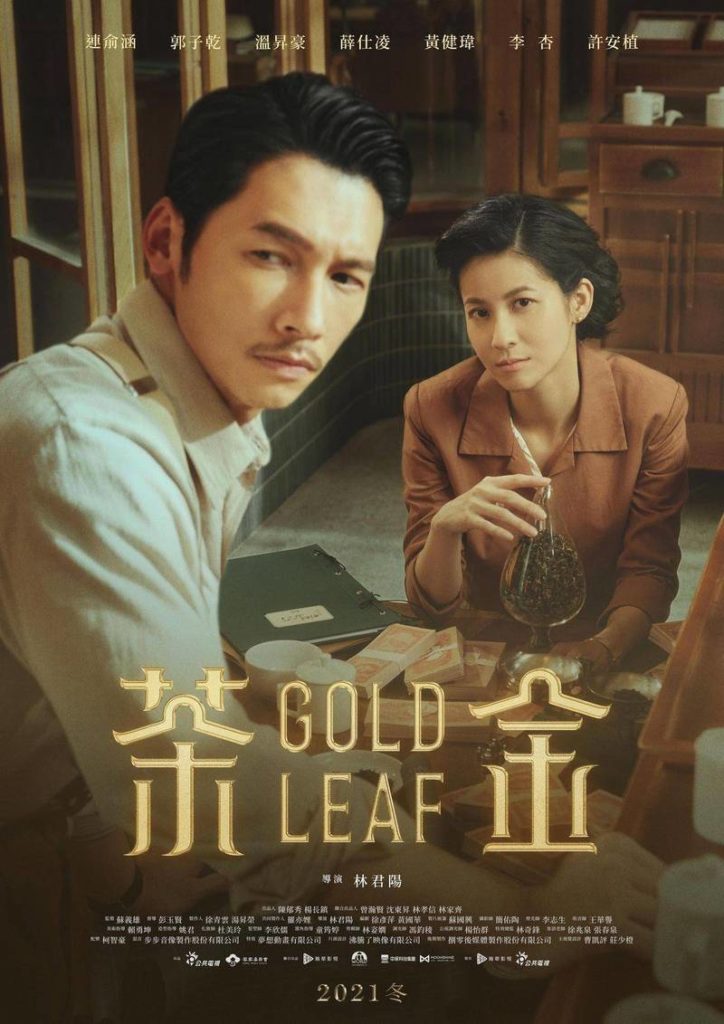by Brian Hioe
語言:
English
Photo Credit: Gold Leaf
DESPITE NO international marketing blitz comparable to Island Nation or SEQALU, Gold Leaf proves the same kind of work, in seeking to dramatize a pivotal period of Taiwanese history. Based on the memoirs of Jiang A-hsin, the founder of the Yong-guang Tea Company, Gold Leaf (茶金) focuses on the Zhang family, a prominent Hakka family of tea manufacturers in Hsinchu in the 1950s. The Jiang family was once Taiwan’s largest exporter of tea.
Interestingly enough, many of the historical players are the same between the three works. Between SEQALU, which is set in 1867, Island Nation, which is set in the 1990s, and Gold Leaf, which is set in the 1950s, Taiwan is in many ways contending with global American influence. SEQALU and Gold Leaf both point to the importance of the Taiwanese tea industry globally, in that Taiwan was a source of tea for American trade in the 19th century, and much US interest in Taiwan was because of its tea industry. On the other hand, in Gold Leaf, the US is seeking to prop up the KMT government, while also attempting to carry out free-market reforms and to loosen state controls over the economy.

Photo credit: Gold Leaf
However, to this extent, Gold Leaf is a much more capable work than SEQALU or Island Nation. SEQALU and Island Nation were both works that focused on History, with a capital H. As a result, where both works suffered was in their characters. A large cast was introduced without much to make viewers care about them, or even keep track of all the different roles.
When very few of these characters came to life in any meaningful way, this made it all the more difficult for readers to become invested in the plot. And, insofar as both SEQALU and Island Nation aimed for international success with non-Taiwanese audiences, audiences that have no prior emotional connection to Taiwanese history are likely to be unsympathetic.
This is not the case with Gold Leaf, which puts its characters front and center. The daughter of the family, Ah-Hsin, who we know from history will eventually rise to leadership of the Zhang family as its first female head, is depicted as sensitive and headstrong but also caught in an arranged marriage that is out of her hands. Her father Fu-ji is also well-characterized, as stubborn but kind, having the interests of his family and those supported by his family first, yet caught in a complicated relationship with his own father. Elements of Fu-ji’s characterization as a generous, but also rational businessman, seem aimed at being a rejoinder to the common stereotype of Hakka as stingy and miserly in Taiwanese society.
Gold Leaf is also well-scripted, in that it is able to balance plots and subplots, main characters and side characters. This was not the case with SEQALU and Island Nation, in which no distinction was made, and viewers sometimes did not know which characters were more important than others.
As with SEQALU and Island Nation, efforts are made to depict Taiwan’s multicultural nature. The Zhang family and other tea merchant families in Hsinchu are depicted as speaking Hakka but also being fluent in Japanese and using a number of Japanese words in daily life, having only until recently been Japanese colonial subjects. Likewise, given Taiwan’s relationship with the US after the KMT came to Taiwan, they have to engage with American trade partners in English.

Photo credit: Gold Leaf
Scenes with English-speaking actors are where SEQALU and Island Nation both falter, such scenes being excruciatingly awkward in both—despite the fact that they are pivotal to the plot. In a pleasant surprise, this is not the case with Gold Leaf, even if American characters so far do not evidence much depth. Ironically, the problem may precisely be the opposite in Gold Leaf, in some scenes featuring Taiwanese characters that are supposed to have shaky English, their contemporary accents evidence that they have at least passable English. And the scenes of US experts attempting to force the Chiang government to adopt currency reforms and relinquish state monopolies prove historically intriguing—with US experts presented as outside interlopers with their own interests in mind, rather than as missionaries of enlightened western civilization.
If there are elements in which Gold Leaf could do better, it is in the rather forced characterization of A-hsin always interceding in her father’s dispute—to the family’s benefit—with a touch of feminine empathy. Although SEQALU, too, tried to emphasize female roles in male-dominated history, this comes off as somewhat embodying gender stereotypes.
To this extent, history is often the history of elites, and Gold Leaf is no different in its focus on a wealthy Hsinchu family as an index of Taiwanese history. Nevertheless, the work still proves an interesting look at this period in Taiwanese history, precisely because it tells the story of history through a human lens, rather than History displacing the perspective of its subjects.



